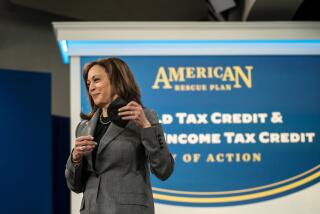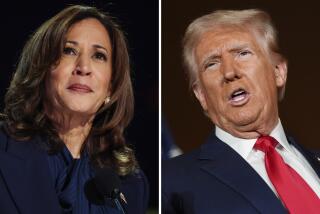Behind the Scenes of the Capital Gains Tax Cut Drama
Although a bitter battle looms first, Congress this fall is finally poised to grant investors a capital gains tax cut.
Exactly how significant a cut will emerge from the Capitol Hill debate is unclear, although the current House plan calls for a drop in the top capital gains tax rate from 28% to 19.8%--the lowest in modern U.S. history.
And despite their glee at that prospect, some Wall Streeters are already worried about what would be the logical initial investor response to any rate cut: a wave of selling that could halt stocks’ 1995 surge, at least temporarily.
Nonetheless, the idea of letting investors keep more of their winnings is almost certainly bullish for securities markets in the long run. It’s probably no coincidence that the last capital gains tax cut--in 1981--was soon followed by the greatest bull market in history.
Yet the backdrop for the capital gains tax cut debate in 1995 is very different from that of 1981. Then, the Reagan era was dawning and gigantic federal budget deficits, made worse by tax reduction, seemed an inevitable price of the new prosperity.
Now, the Republican Congress is hellbent on balancing the budget by 2002. So any of the myriad tax cuts currently on the Republican wish list, including a capital gains cut, must fit within the balanced-budget program, at least on paper.
*
Therein lies the challenge for Congress, even before it engages the White House in the usual Republican-Democrat sparring over the societal merits of a capital gains tax cut (i.e., the handout-for-the-rich vs. job-creation debate).
Here’s a playbook, of sorts, for the tax-cut fight that will unfold in Washington in coming weeks:
* As part of the Republican “contract with America,” the House last spring voted for roughly $367 billion in tax cuts over the 1996-2002 period. The massive package had something for every constituency, ranging from a $500-a-child tax credit for families to an increase in the estate-tax exemption to a $5,000 adoption tax credit for lower-income couples.
The capital gains tax cut that passed the House would allow investors to exclude 50% of any long-term gains--that is, gains on assets held more than one year--from taxation, retroactive to last Jan. 1. So investors in the top federal marginal tax bracket, now 39.6%, would in effect see their capital gains tax rate reduced to 19.8%.
Currently, the maximum capital gains rate is 28%; it was raised to that level in 1986 from 20%.
* While the House was busy cooking up a record tax-relief package last spring, the Senate merely voted to discuss tax cuts at a later date, meaning now.
The Senate authorized up to $245 billion in unspecified tax cuts, but only if Congress could agree on a budget plan that reduces the annual federal deficit to zero by 2002.
* In the weeks ahead, the House and Senate must approve appropriations bills and other implementing legislation to put the government on a clear path to a balanced budget within seven years.
Once that herculean legislative task is accomplished, and the Congressional Budget Office certifies that the balanced-budget plan is indeed realistic, then House and Senate conferees can begin to fashion tax cut proposals.
*
But even then, the House and Senate will begin debate far apart on a tax-cut plan. The House has voted for $350 billion-plus in cuts; the Senate, $245 billion.
What’s more, the Senate’s $245-billion ceiling is rickety, notes Charles A. Gabriel Jr., Washington analyst for Prudential Securities.
The Senate would fund $170 billion of its $245 billion in tax cuts with the predicted interest savings on the federal debt between now and 2002, assuming that market interest rates decline as the deficit shrinks--a dicey assumption.
Even after allowing for that interest-savings “dividend,” the Senate plan still would require an additional $75 billion in budget cuts and/or added revenue to provide for $245 billion in total tax cuts.
For the sake of argument, let’s assume that $245 billion is the maximum tax cut package that Congress will have to work with. House Ways and Means Committee Chairman Bill Archer (R-Tex.) appears resigned to that eventuality: To allow his $350-billion-plus bill to be considered in a House-Senate conference without reopening it for debate in the House, he will use a procedural move to essentially reduce every provision in the House bill by an equal percentage, until the total value of the House tax cuts is $245 billion.
Then the questions become: Which tax cuts survive intact, which are scaled back, and which are eliminated altogether? How high a priority will a capital gains tax cut be given, when so many constituencies are jostling at the tax-cut feeding trough?
Almost everybody agrees that for political reasons, the biggest element in the House tax-relief plan--a per-child tax credit--will survive in some form. If Congress goes along with the House proposal as is, families would get a $500 credit for each child, although the credit would be phased out for people earning $200,000 or more.
The estimated cost of that proposal: $163 billion in lost revenue to the Treasury between 1996 and 2002. So that idea alone would eat up 67% of a $245-billion tax cut, leaving $82 billion with which to accommodate the remaining $190-billion House tax cut wish list.
The capital gains tax cut proposal, as now configured by Archer’s committee, would cost the Treasury about $63 billion in revenue over seven years. That makes it the second-most-expensive provision in the House plan.
That wouldn’t appear to bode well for the capital gains tax cut’s survival. Yet supporters believe their chances of enacting the cut--on some scale--remain very high.
Archer, for one, refuses to back down. “Chairman Archer has stated unequivocally that in order to create jobs in our nation, a capital gains tax cut is a priority,” a spokesman said Friday.
Also buoying hopes: Senate Majority Leader Bob Dole (R-Kan.) recently sent a letter to Archer saying that he and 41 other senators support the House’s language on a capital gains tax cut.
That isn’t a Senate majority, of course. But capital-gains champions in the Senate now have a potential new cheerleader in a powerful post: Sen. William V. Roth Jr. (R-Del.), who succeeds the resigning Sen. Bob Packwood (R-Ore.) as chairman of the Senate Finance Committee, is a longtime supporter of capital gains tax relief.
A Roth spokeswoman on Friday listed Roth’s tax cut priorities in this order: Expand the deductibility of Individual Retirement Accounts; reduce the capital gains tax; change the estate tax regime.
What about President Clinton? He wants tax cuts too, but his position on a capital gains cut remains murky. What the Republicans must do, analysts agree, is make sure that the final bill is mostly about middle-class relief, which Clinton conceivably could support even if a capital gains cut is included.
But that probably means a scaled-down capital gains cut. One way to lower the cost of the cut would be to give up on Archer’s pet idea to index capital gains to inflation, a nice bit of protection for investors (at the Treasury’s expense) but an extremely complex idea to implement, analysts agree.
Congress also could scale back the size of the exclusion--say, allow investors to exclude 40% of long-term gains from taxes instead of 50%.
And the effective date could be moved ahead, perhaps to Jan. 1, 1996, instead of making it retroactive to last Jan. 1.
*
If you assume that some kind of capital gains tax cut is coming, what will it mean for Wall Street?
Offered the opportunity to keep more of their gains than ever before, it’s a good bet that many individual and institutional investors would opt to sell long-held securities, says Peter Anderson, head of money management firm IDS Advisory in Minneapolis.
If the bull market is already running out of steam, Anderson says, “that selling might well exacerbate any downturn.”
Indeed, the capital gains tax cut of 1981 was immediately followed by a bear market--although the recession of that period was the fundamental problem pulling stocks down.
By August, 1982, however, with the recession ending, the mother of all bull markets was born. And there is little question that stocks’ fresh appeal in the mid ‘80s stemmed in good part from the tax-advantaged status of capital gains compared with fully taxable income such as interest.
So, even if a capital gains tax cut results in an initial wave of selling, Wall Street pros say investors should consider the long-term outlook: Many of the same people selling will have a huge incentive to put their profits back into stocks precisely because capital gains will have an even greater tax advantage than before over interest-paying investments.
(BEGIN TEXT OF INFOBOX / INFOGRAPHIC)
Tax Cut Hierarchy
The tax cuts proposed in the House-passed “contract with America” would cost the Treasury an estimated $367 billion between 1996 and 2002. As Congress gets to work reconciling these proposed cuts with budget realities, here’s how various tax cut provisions in the contract rank by dollar impact.
Item: $500 per-child tax credit
Cost to Treasury: $162.9
*
Item: Capital gains tax cut
Cost to Treasury: $63.2
*
Item: Repeal of Social Security benefits tax
Cost to Treasury: $29.6
*
Item: Phase-out of corporate alternative min. tax
Cost to Treasury: $27.0
*
Item: Increase Social Security earnings limit
Cost to Treasury: $12.5
*
Item: Increase estate and gift tax exemption
Cost to Treasury: $12.3
*
Item: Marriage-penalty tax credit
Cost to Treasury: $12.2
*
Item: “American Dream” savings account
Cost to Treasury: $6.8
*
Item: Misc. other tax cuts
Cost to Treasury: $40.8
*
Item: Total House bill tax cuts
Cost to Treasury: $367.0
Source: Prudential Securities
More to Read
Get the L.A. Times Politics newsletter
Deeply reported insights into legislation, politics and policy from Sacramento, Washington and beyond. In your inbox three times per week.
You may occasionally receive promotional content from the Los Angeles Times.










